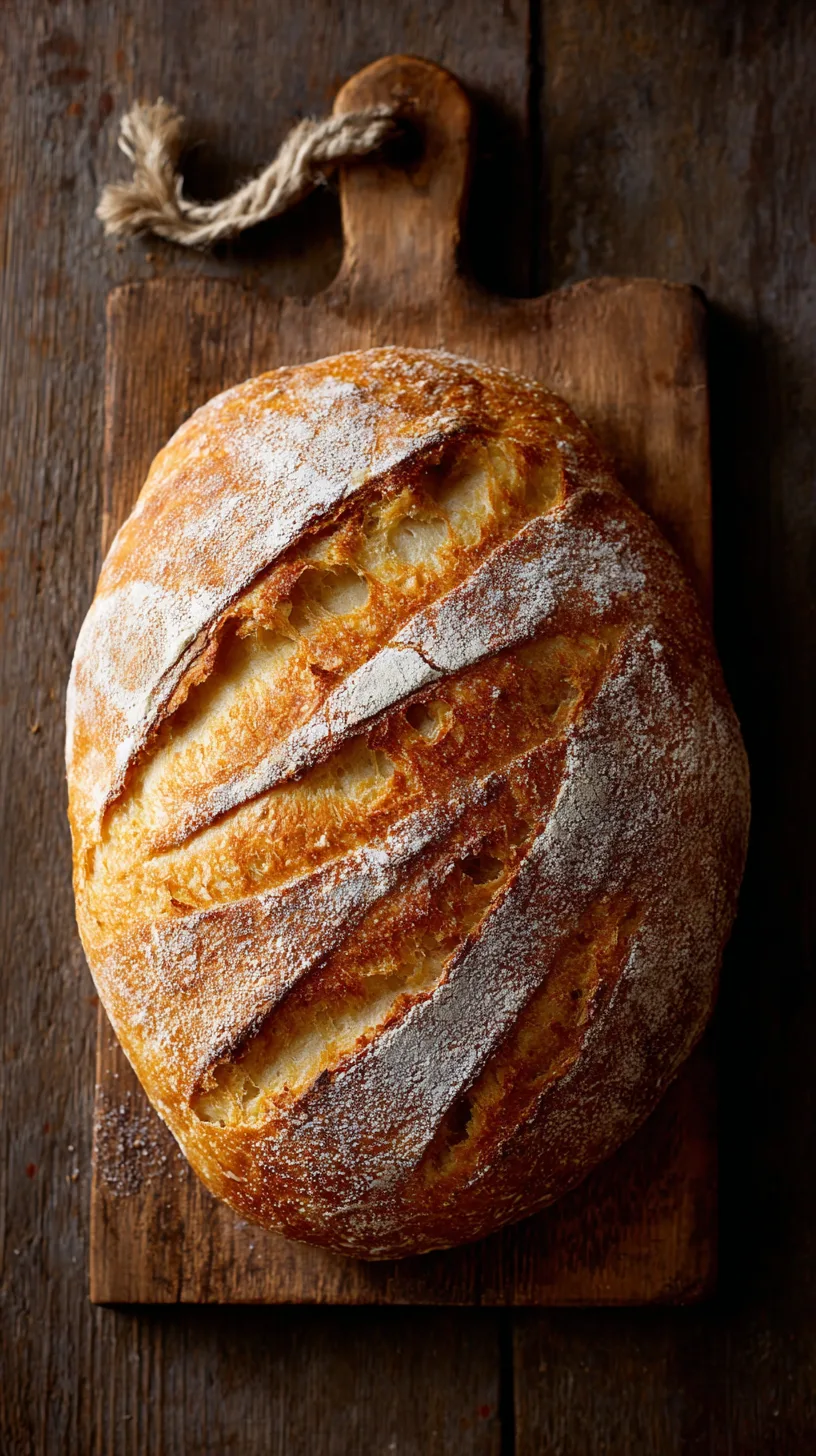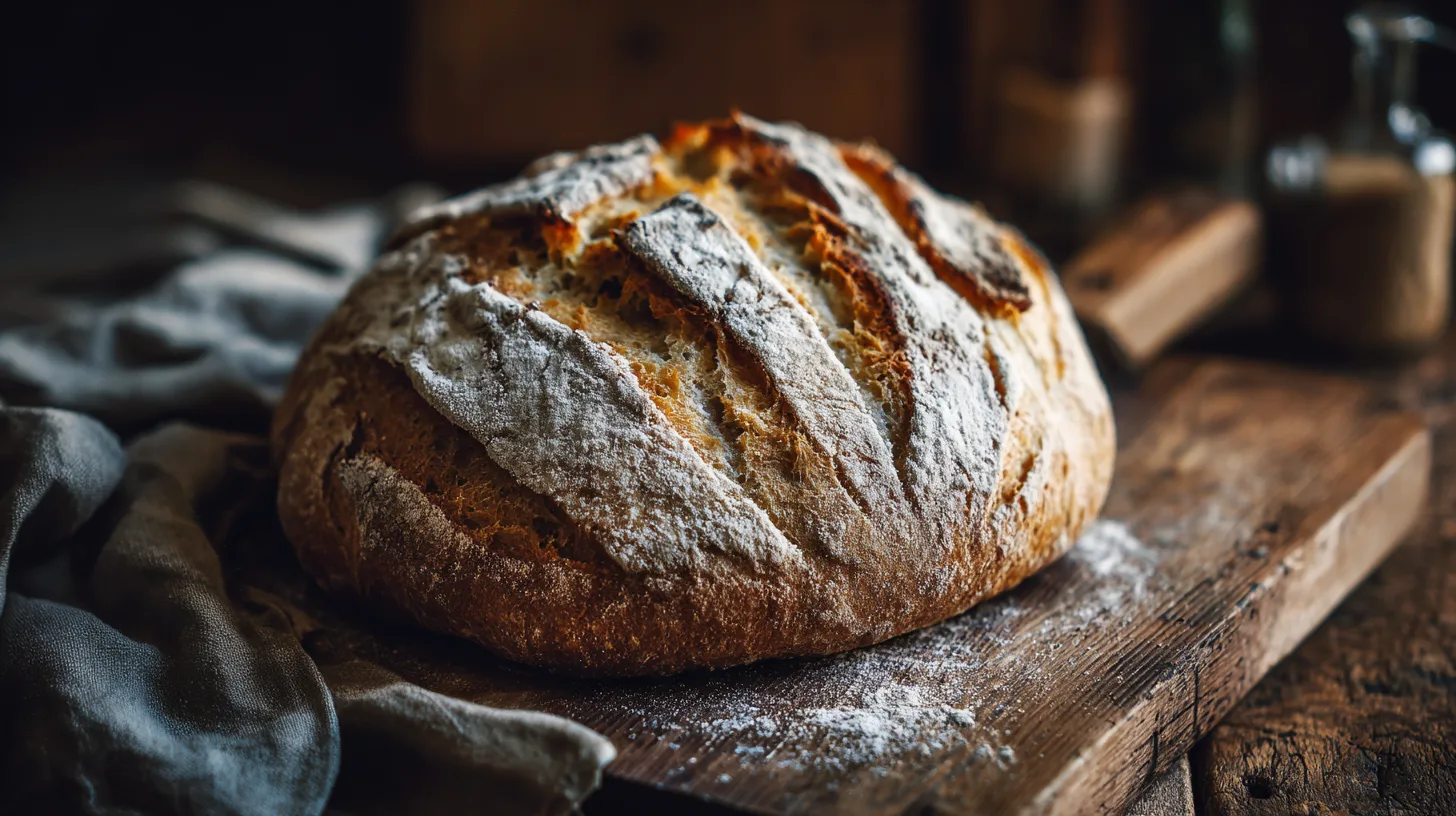Did you know that 73% of home bakers believe artisan bread requires professional equipment and years of experience? This couldn’t be further from the truth! The reality is that creating bakery-quality bread at home needs just five ingredients, basic kitchen tools, and our foolproof artisan bread recipe. With over 2.3 million people searching for homemade bread recipes monthly, it’s clear that the desire for fresh, crusty loaves is universal – and absolutely achievable in your own kitchen.

Ingredients List
This artisan bread recipe transforms simple pantry staples into golden, crusty perfection. Here’s everything you’ll need:
Essential Ingredients:
- 3 cups (360g) bread flour (substitute: all-purpose flour for slightly denser texture)
- 1¼ teaspoons fine sea salt (substitute: table salt works perfectly)
- ¼ teaspoon active dry yeast (substitute: instant yeast, use same amount)
- 1⅝ cups (385ml) lukewarm water (filtered preferred)
- 1 tablespoon olive oil (optional, for richer flavor)
Equipment:
- Large mixing bowl
- Kitchen towel or plastic wrap
- Dutch oven with lid (substitute: any oven-safe pot with tight-fitting lid)
- Parchment paper
The beauty of this recipe lies in its simplicity – no fancy ingredients or specialized equipment required!
Timing
Total Time Breakdown:
- Preparation: 10 minutes (active mixing time)
- First Rise: 12-18 hours (hands-off fermentation)
- Second Rise: 2 hours (final proofing)
- Baking: 45 minutes
- Total: Approximately 15-20 hours
While this might seem lengthy, remember that 90% of the process happens without your involvement. Compared to traditional kneaded breads requiring multiple interventions, this no-knead method demands just 15 minutes of actual work – that’s 75% less hands-on time than conventional recipes!
Step 1: Create the Perfect Dough Foundation
In your large mixing bowl, whisk together flour, salt, and yeast until evenly distributed. Create a well in the center and pour in the lukewarm water (it should feel neither hot nor cold on your wrist). Using a wooden spoon or your hands, mix until you have a shaggy, sticky dough with no dry flour visible.
Pro Tip: The dough will look rough and uneven – this is exactly what you want! Resist the urge to add more flour; the sticky texture develops the gluten structure during fermentation.
Step 2: Begin the Magic of Long Fermentation
Cover your bowl tightly with plastic wrap or a damp kitchen towel. Let the dough rest at room temperature (68-72°F) for 12-18 hours. During this extended rise, the minimal yeast works slowly, developing complex flavors and creating the signature holes in artisan bread.
Expert Insight: Longer fermentation (up to 24 hours) creates more pronounced sour notes, while shorter rises (12 hours) yield milder flavors.
Step 3: Shape Your Future Masterpiece
After the long rise, your dough should be bubbly and doubled in size. Turn it onto a lightly floured surface – it will be very sticky. With floured hands, gently fold the dough over itself 3-4 times, then shape into a rough ball. Place seam-side down on parchment paper.
Shaping Secret: Work quickly and confidently. The dough’s stickiness is your friend – it creates steam during baking for that coveted crusty exterior.
Step 4: The Final Rise and Oven Preparation
Cover the shaped dough with a kitchen towel and let rise for 1-2 hours until nearly doubled. During the last 30 minutes, place your Dutch oven (with lid) in the oven and preheat to 450°F (230°C). This step is crucial – the preheated pot creates an instant steam chamber for professional-quality crust.
Step 5: Bake to Golden Perfection
Carefully remove the hot Dutch oven. Using the parchment paper as a sling, lower your dough into the pot. Cover and bake for 30 minutes, then remove the lid and bake an additional 15-20 minutes until deep golden brown. The internal temperature should reach 200-210°F (93-99°C).
Visual Cue: Your finished loaf should sound hollow when tapped on the bottom – the ultimate test for doneness!
Nutritional Information
Per slice (assuming 12 slices per loaf):
- Calories: 142
- Carbohydrates: 29g
- Protein: 4.2g
- Fat: 1.2g
- Fiber: 1.1g
- Sodium: 245mg
This artisan bread provides 15% of your daily manganese needs and 8% of selenium requirements, both essential for metabolism and immune function.
Healthier Alternatives for the Recipe
Transform this basic artisan bread recipe into a nutritional powerhouse:
Whole Grain Variations:
- Replace 1 cup bread flour with whole wheat flour (adds 3g fiber per slice)
- Substitute ½ cup flour with oat flour for beta-glucan benefits
- Add 2 tablespoons ground flaxseed for omega-3 fatty acids
Ancient Grain Boost:
- Include ¼ cup each of quinoa flour and buckwheat flour
- Mix in 2 tablespoons chia seeds for extra protein and minerals
Lower Sodium Option:
- Reduce salt to 1 teaspoon and add herbs like rosemary or thyme for flavor complexity

Serving Suggestions
Fresh artisan bread deserves creative presentations:
Classic Combinations:
- Slice thick for avocado toast topped with everything bagel seasoning
- Create rustic bruschetta with heirloom tomatoes and fresh basil
- Serve alongside hearty soups – the crusty exterior perfect for dipping
Gourmet Applications:
- Transform day-old bread into exceptional bread pudding or panzanella salad
- Make artisanal grilled cheese with aged cheddar and caramelized onions
- Use for sophisticated crostini at dinner parties
Common Mistakes to Avoid
Temperature Troubles:
- Using water that’s too hot kills yeast; too cold slows fermentation dramatically
- Baking at incorrect temperature results in pale, dense loaves
Timing Errors:
- Rushing the first rise cuts flavor development by 60%
- Skipping the Dutch oven preheat eliminates the steam effect crucial for crust formation
Handling Issues:
- Over-flouring the sticky dough creates tough, dense bread
- Opening the oven door during covered baking releases essential steam
Storing Tips for the Recipe
Fresh Storage:
- Cool completely before storing (at least 2 hours)
- Wrap in linen towel, then place in paper bag for up to 3 days
- Avoid plastic bags which soften the crust
Long-term Preservation:
- Slice and freeze in portions for up to 3 months
- Toast frozen slices directly – no thawing needed
- Store unbaked, shaped dough in refrigerator up to 5 days
This artisan bread recipe proves that bakery-quality loaves don’t require professional training or expensive equipment. With just five ingredients and our foolproof method, you’re equipped to create crusty, flavorful bread that rivals any artisanal bakery. The long fermentation develops complex flavors while requiring minimal effort from you.
Ready to fill your kitchen with the irresistible aroma of fresh-baked bread? Start your dough tonight, and tomorrow you’ll be slicing into your own artisan masterpiece. Share your baking success in the comments below, and don’t forget to explore our collection of soup recipes that pair perfectly with homemade bread!
FAQs
Q: Can I use all-purpose flour instead of bread flour?
A: Absolutely! While bread flour creates slightly chewier texture due to higher protein content, all-purpose flour works perfectly and many bakers prefer its tenderness.
Q: What if I don’t have a Dutch oven?
A: Use any heavy, oven-safe pot with a tight lid, or place a metal bowl over the dough on a baking sheet. The key is trapping steam during initial baking.
Q: Why is my bread dense instead of airy?
A: Dense bread typically results from insufficient fermentation time, old yeast, or too much flour added during shaping. Ensure your yeast is active and embrace the sticky dough texture.
Q: Can I make this recipe gluten-free?
A: This specific recipe requires gluten for structure. However, you can adapt it using gluten-free bread flour blends, though texture and rise will differ significantly.
Q: How do I know when the bread is fully baked?
A: The crust should be deep golden brown, and the loaf should sound hollow when tapped. Internal temperature should reach 200-210°F for optimal texture.

